Giving effective feedback should be a core component of any company’s culture. Done right, feedback can transform an underperforming employee into an A player, but get it wrong and both star and struggling performers can fall by the wayside.
Let’s take a look at ten rules of thumb you can adopt to ensure that your feedback sessions effectively communicate the issues at hand, and ultimately promote positive change both with the employee at hand and the company as a whole.

1. Prepare for your feedback session
Before sitting down with an employee to give them feedback, it’s important to check a few preparatory boxes to ensure the meeting is productive and leads to positive results. After gathering all the information you need about the issue at hand (evidence of incomplete work or missed deadlines, feedback from other members of staff, and so on), create a discussion plan outlining what you want to talk about, anticipated reactions and follow on questions.
Understanding what you want to get out of the meeting is important, but listening to the other party should be at the forefront of any feedback meeting. Be prepared to take notes, and consider the potential barriers to progress which might emerge during the meeting, particularly if corrective feedback is being offered to under-performing employees.
2. Time your feedback wisely …
Feedback should be an ongoing process in your performance management, but choosing the right moment to deliver it is key to getting the best results.
Good results should always be highlighted; if an employee makes good use of resources and displays effective lateral thinking, or completes a project to a high standard, there is an opportunity to spotlight what went well and encourage these behaviours moving forwards.
On the other hand, when a problem becomes too serious to dismiss any longer, it’s time to step in with constructive feedback to mitigate against negative behaviour before it has any further impact on the workplace.
3. … And know when not to deliver it
Conversely, giving feedback at an inappropriate moment can have a negative impact on other employees and the workplace as a whole, and should be avoided.
Situations where management doesn’t have all the information needed to make an informed response, or where the recipient of the feedback is powerless to act on it should be avoided until more information can be gathered or a suitable solution can be proposed.
The employee receiving the feedback may be vulnerable, and not in a position emotionally to deal with it. Likewise, the person charged with delivering the feedback might be too distracted or impatient to be able to deliver it even-handedly. If this is the case, avoid giving feedback until a more suitable opportunity presents itself.
4. Distinguish feedback from coaching and performance appraisals
When dealing with an under-performing employee further coaching may be required in order to improve their performance. In this case, it needs to be handled differently and not drawn into the feedback process.
Distinguishing between feedback, coaching and performance appraisals ensures any meetings are kept on the right track. Coaching to improve skills requires a variety of participants and a formal routine, while performance appraisals are intended to evaluate past work at specific intervals throughout the work year.
Feedback should be viewed as an ongoing, more casual process geared towards reinforcing or changing behaviour.
5. Plan for potentially volatile encounters
As a good rule of thumb, potentially volatile encounters should be avoided whenever possible, but when they are unavoidable some steps can be taken to mitigate against the worst-case outcomes.
While planning for the feedback meeting, ensure that you have the key points written down ready to avoid being distracted. Keep these points simple so that off-topic discussions are reduced to a minimum. Rehearse how to react to any volatile outbursts from the employee, and try to soften any defensiveness with phrases that indicate an understanding of their perspective.
Ultimately, a calm disposition and avoiding judgemental phrases will help to reduce volatility and keep the focus constructive.
6. Set the tone for delivering feedback
It is unusual for any issues with tone to arise when delivering positive feedback, but when corrective feedback needs to be discussed it is important to create an atmosphere conducive to mutual understanding and progress.
When meeting with such an employee, remove physical obstacles from between you and try to adopt the tone of a reassuring teacher without being patronising. Be sensitive to the personality type of the employee in question, considering how their gender, race or age might play a role, and also what personality type they are.
Perhaps most importantly, be aware of their perspective and consider what it is they might need to hear in order to come away from the feedback meeting with new goals or systems to help improve their performance.
7. Understand your employee’s reactions

Delivering effective feedback is about engaging in a dialogue rather than lecturing or admonishing the employee, so it is crucial to pay close attention to their responses.
Actively listen to the employee’s responses to the feedback, making sure to ask questions where any further information or clarification is needed. Learn to observe non-verbal cues – if the body language is out of synch with the words, or the person appears to be uncomfortable, any reactions should be gauged accordingly.
Paraphrasing the employee reactions is a good way to demonstrate an intent to understand their position, allowing them to clarify any miscommunications and bring new information to the discussion.
8. Assess your feedback delivery
After a feedback session, assessing what went right or wrong will help to ensure that future sessions are more productive. When assessing feedback, consider:
- Process. Did you plan and initiate the meeting well? Were all the relevant points of the meeting covered? If appropriate, did you formulate an action plan?
- Relationship. Did your communication style elicit a favourable response from the employee? Was it evident that there was trust and respect between you and the employee?
- Results. Are the right changes there moving forwards? Do you and the employee have the same expectations? Has progress been made?
9. Frame feedback as an ongoing process
Ultimately, the idea of giving positive feedback as an ongoing process should be a part of your company’s culture. Fostering an ethos in which employees understand how feedback is intended to improve their experience in the company will create a feedback loop where feedback is freely given on a regular basis.
The Harvard Business Review publication, Giving Effective Feedback, suggests using the following mantra: “Every single day, the people you work with and those who work for you should know how they’re doing.” Set regular examples of the feedback process and be open to feedback from employees to build it into your company’s core system.
10. Give positive feedback in public
Delivering positive feedback in public and spotlighting it to the wide workplace is an effective way for your core company values to be intrinsically understood by other employees. Moreover, all members of staff should be encouraged to do the same, increasing the number of feedback flashpoints and encouraging everyone to embrace the concept.
Rather than praising someone’s effort, choose to focus on their ability. Research from Stanford psychologist Carol Dweek suggests that praising effort – even if those efforts fail – builds determination. Avoid following up positive feedback with criticism, while doing this in public empowers everyone, not just the member of staff receiving the praise.






